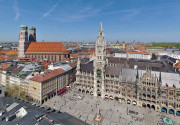Berlin Universities: Visit these famous institutions for free
With Berlin’s three public universities—Humboldt Universität zu Berlin (Humboldt University), Freie Universität (Free University), and Technische Universität (Technical University)—and dozens of private colleges, Germany’s capital is crawling with students studying everything from “Kunst” (art) to “Wirtschaft” (business).
With the oldest of the three, Humboldt, in the midst of a 200th-anniversary celebration, it’s a great time to get in touch with Berlin’s collegiate side. German schools aren’t really known for their wild celebrations, so don’t expect to stumble across raucous soccer matches or wild kegger parties while touring the two most visit-worthy campuses.
Instead, FU and HU boast historic buildings, memorable museums, ultra-contemporary libraries, and tasty, Cheapo-friendly “Mensas” (cafeterias).
Humboldt Universität zu Berlin
Founded in 1810 by the education innovator Alexander von Humboldt, HU is regarded as the first “modern” university because it offered courses in diverse subjects, such as chemistry and physics, in addition to standard classes on the humanities.
Since its debut, the university’s (now faded) halls have hosted dozens of star students and faculty, including the economist Karl Marx, the folklorists Jacob and Wilhelm Grimm, the philosopher Georg Wilhelm Friedrich Hegel, and the physicist Albert Einstein.
A statue of Humboldt guards the central building (Unter den Linden, S-bahn: Unter den Linden), a gorgeous 19th-century palace on Berlin’s monument-studded main drag, Unter den Linden. After browsing the used book stalls set up in the front yard (Mon.–Sat.), pop inside the entrance hall to marvel at the marble-bedecked East Germany-era staircase. It features a gilded quote by Marx.
Stroll through the back courtyard to reach the university’s newest building. Designed by the Swiss architect Max Dudler, the streamlined Brüder Grimm Zentrum (Brothers Grimm Center, Geschwister-Scholl-Str. 1/3, S/U-bahn: Friedrich Str.) houses the university’s central library.
Freie Universität
Nestled in Dahlem (U-bahn: Dahlem Dorf), a leafy suburb southwest of the center, “the Oxford of Germany” is newer, bigger, and more highly-regarded than Humboldt. In fact, HU is still fuming about the fact that FU beat it out for a spot on the exclusive list of German Centers of Excellence, a distinction awarded to the country’s best schools.
In addition to its trio of fantastic museums—the Asian Art Museum, the Ethnological Museum, and the Museum of European Cultures—FU boasts an impressive library of its own.
Opened in 2005, Sir Norman Foster’s cerebral Philologische Bibliothek (Philological Library, Habelschwerdter Allee 45) is literally shaped like a brain. Step inside the so-called “Berlin Brain” to find a curvaceous central chamber that plays host to nearly a million books.
If you find yourself in need of a study break, head to one of the campuses many Mensas for a cheap and filling meal. The best of the bunch, the bright orange Mensa FU II (Otto-von-Simson-Str. 26), is right next door to the library.











Karl Marx is not an economist… he’s a philosopher and with a major “P” in it.